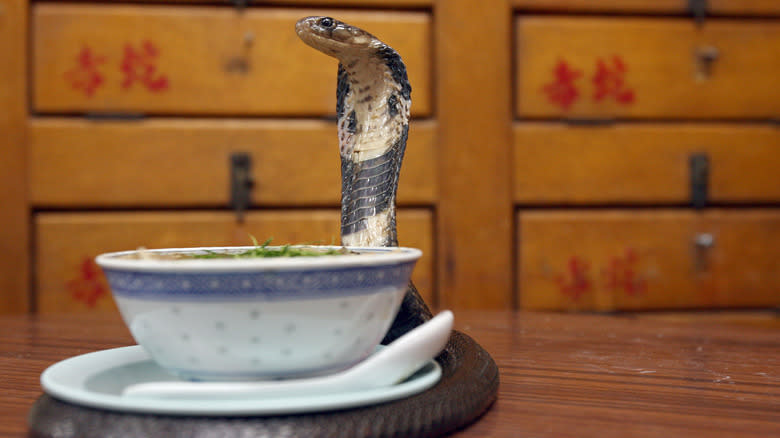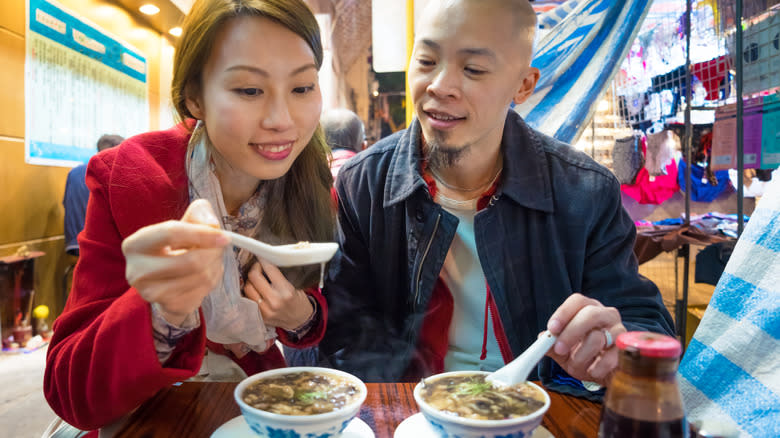Why The Once-Popular Snake Soup Is Slowly Disappearing From Menus In China

Chinese cuisine has many soups known for incorporating ingredients that you would likely never see in the West such as shark fin soup, bird's nest soup, and soft shell turtle soup — but have you ever heard of snake soup? Snake soup is a favored dish in the winter when people step inside the se wong scattered around Hong Kong. Se wong translates to snake king, and it's the general term used for restaurants that serve snake meat. Inside you'll find a wall of wooden cupboards which, if you were to open them, would reveal a variety of poisonous and non-poisonous snakes ready to be made into a warming winter soup known as se gang.
Snake soup contains as many as five different types of snake meat which can be combined with chicken, ham, mushrooms, fish maw (aka the swim bladder), or pork bones. It's a brothy mix often seasoned with ginger, chrysanthemum leaves, and citrus peel to create a meaty but flavorful dish.
Snake meat itself is often described as being a chewier version of chicken. Per traditional Chinese medicine, snake meat is full of yang. This refers to the warmth of the overall dish. Balancing the yin (cold) and yang (hot) energies within the body is believed to be a way to build strength and good health. Snake meat is also cherished for its ability to fight off joint pain from rheumatism and arthritis, increase blood circulation, and provide benefits for the skin.
Read more: 20 Popular Canned Soups, Ranked Worst To Best
How The Snake Got Its Soup

Legend has it that the Chinese have been eating snake soup since the Liang Dynasty which lasted from 502 to 557 CE. It was originally enjoyed only by the Chinese nobility and other wealthy members of society. In the 1900s it became more widely available thanks to the efforts of prominent chef Jiang Taishi, known as the "first man of the hundred Cantonese foods." He ran a kitchen that's considered the birthplace of many traditional Chinese dishes, including five-snake soup, and trained many up and coming chefs of the time.
But snake soup was still an expensive luxury until the 1950s when the price of snake meat became affordable to working class people. The proliferation of new snake meat restaurants popping up all over Hong Kong is one of the reasons why the dish is so closely connected to the history of the region. It's such a popular dish that Pizza Hut actually released a snake soup pizza in November of 2023. It was only available for a few weeks but it's still a testament to the significance of snake soup in China.
Slithering Downhill

Despite this rich heritage, the age of the se gang may be coming to an end. Many snake meat restaurants are family businesses, and current restaurant owners are having trouble finding someone willing to take over now that they are reaching retirement age. This is exacerbated by the tendency for China's young and educated population to emigrate to other countries.
The problems facing snake meat restaurants aren't entirely internal, though. Since the Covid pandemic started, Hong Kong residents have been skeptical of eating snakes because they were seen as possible transmitters of the disease. This has been proven false, but the fear has certainly lingered, making it more difficult to bring in customers, regardless. Even more damaging was the theory that Covid-19 came from a wet market, which was still at play in the early months of 2020. The Chinese government banned the sale of wildlife, including snakes, in the interest of food safety. The ban hit the snake breeding industry in a major way, impacting the supply chain side of things as well.
Outside of the pandemic, there are still challenges ahead. There's been concern over the treatment of the snakes themselves, as many shops will skin the snakes alive as part of the cooking process. For the younger generation especially, this has been one reason to dine on snake soup less frequently. Time will tell if this centuries-old tradition can survive into the next one.
Read the original article on Tasting Table.

